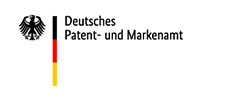Glossary
DEPATIS
Database for patent documents of the DPMA. It is available to the public on the Internet at https://depatisnet.dpma.de. Users may comfortably search for the desired subject at their own PCs, before filing an application.
DEPATISnet
Online portal of the "DEPATIS" database for patent documents of the DPMA. It is accessible for all users via the Internet for search purposes (https://depatisnet.dpma.de).
DPMA
Acronym for the official name "Deutsches Patent- und Markenamt" (German Patent and Trade Mark Office). The DPMA is a higher federal authority, subordinate to the Federal Ministry of Justice and Consumer Protection. It is the central authority in the field of industrial property protection in Germany.
Utility model
It is often called "small patent" or "petty patent". It is an industrial property right for an invention which can be obtained without examination by an expert of the DPMA (a so-called patent examiner).
Few other countries besides Germany, eg. Japan, issue utility models. The US, France or the United Kingdom do not have this type of IP protection. The DPMA publishes the utility model within a few months after the application has been filed, in contrast to the patent procedure in which the application is published after a period of 18 months.
The utility model can be kept in force for 10 years, under the same conditions as a patent (Sec. 23 Utility Model Law). During that time, utility models are subject to the payment of annual fees, just like patents. The three-part document ID for utility models (DE - number - kind code) has the suffix "U1".
Country codes
Patent documents always have a country code to indicate the country of origin of the publication.
Here the most important codes in alphabetical order:
CH = Switzerland
DD = former GDR
DE = former West-Germany and unified Germany
EP = European Patent Office (European Patent Convention)
ES = Spain
FR = France
GB = United Kingdom
IT = Italy
JP = Japan
US = United States of America
WO = WIPO (World Intellectual Property Organization, Geneva)
Offenlegungsschrift (published patent application)
Documents constituting "Offenlegungsschrift" in Germany have the suffix A1 in the three-part document ID (DE + number + kind code). In former decades, the term "Offenlegungsschrift" was explicitly printed on the document.
Every idea for which an application is filed with the DPMA must be published after 18 months at the latest, pursuant to the Patent Law (the technical jargon is "laid open"= "offengelegt"), in order to provide information on the invention to the public.
Until 2004 certain documents of patent procedures (the description, the technical drawings and the claims, containing the subject-matter for which the applicant originally sought protection) were printed as a so-called "Offenlegungsschrift" and published in the patent gazette (Patentblatt).
Since 2004, Patent Gazette has been published only in digital form at DPMAregister.
Patent
When an applicant files an invention in writing with the DPMA, s/he can furnish a request for examination to see whether or not the invention is patentable. The request for examination can be filed up to seven years from the filing date. In this context, detailed information is available at: Request for examination.
After the request for examination has been filed, an expert (patent examiner) of the DPMA will assess whether the invention fulfils the necessary patent requirements.
Patents may be valid for a period of 20 years from the day of filing the invention with the DPMA. The applicant must pay annual fees to keep the patent in force. If the fees are not paid, the patent lapses and any person may commercially use the invention. This applies also when the patent expires after 20 years.
Patent specification
Where patent examination has been requested and the invention has been found patentable by the patent examiner, a patent specification is published in the patent gazette (compare "Offenlegungsschrift").
Kind codes of patent documents
In Germany there are three kinds of documents depending on the legal status and the type of the patent request.
Every patent document can be exactly identified by its document ID, indicated in the header of current publication. It consists of a two-letter country code "DE", a file number or a publication number and a two-letter kind code (DE + number + kind code):
Offenlegungsschrift (published patent application) = A1
Patent specification = B or C + number
Utility model = U1
eg. DE 199 99 99 C2 = patent specification from Germany
This code has been frequently changed over the years so that, in old publications, the type of publication is indicated by a two-letter code between the country code DE and the number: GM stands for utility models, PS for patent specification and OS for Offenlegungsschrift (published patent application).
